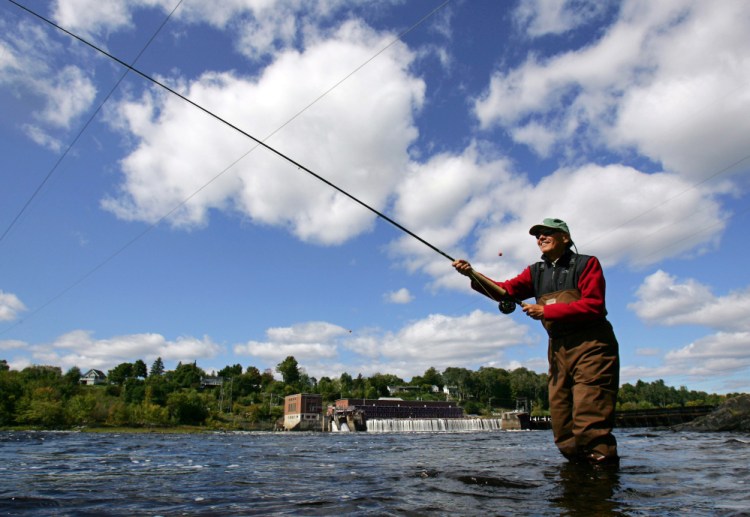Preventing the long-imperiled Atlantic salmon from disappearing from American waters will require the U.S. to put pressure on Inuit fishermen in Greenland to stop harvesting a fish that has fed them for hundreds of years, federal officials say.
The salmon were once found from Long Island Sound to Canada, but their population has cratered in the face of river damming, warming ocean waters, competition for food with non-native fish and, officials say, continued Greenlandic fishing.
Now, federal officials have outlined an ambitious plan to try to save the Atlantic salmon that they say will require removing dams, creating fish passages and fostering cooperation with Inuit fishermen some 2,000 miles away from Maine, where most of America’s last wild Atlantic salmon spawn.
“We’ve tried everything possible to negotiate with Greenland to find alternatives to find out how they can lessen impacts on U.S. fish,” said Dan Kircheis, a fisheries biologist with the National Marine Fisheries Service. “This is part of their culture, this is part of who they are, this is something they’ve always done. We are trying to work with them to realize the fish they are fishing for originate in Canada, in U.S. waters, in Europe, and these populations are in decline.”
The National Oceanic and Atmospheric Administration has said the final remnants of the wild Atlantic salmon population in U.S. waters live in a handful of rivers and streams in central and eastern Maine. A 2014 count found less than 300 salmon in the Penobscot River, which has the largest wild Atlantic salmon population in the country.
Federal authorities listed the Gulf of Maine’s Atlantic salmon population as endangered in 2000. They were once found in almost every river north of the Hudson, but since the 18th century they have declined to just 11 rivers, NOAA has said. The Atlantic salmon and the Pacific Chinook salmon are the largest salmon species.

Farm-raised Atlantic salmon move across a conveyor belt as they are brought aboard a harvesting boat near Eastport.
Atlantic are the most commonly farmed species of salmon, and demand has grown exponentially since the 1990s. Farms produced more than 2 million tons of the salmon, prized for its high protein content and omega-3 fatty acids, for the first time in 2012.
The wild fish leave Maine rivers in the spring, and most eventually end up off Greenland, an autonomous country that is part of the Danish Realm, along with Denmark and the Faroe Islands. NOAA issued a report in February that identified the salmon as one of a handful of species listed under the Endangered Species Act that need “immediate, targeted efforts” to stabilize their populations and stave off extinction.
NOAA’s report states that a critical negotiating point will be the annual meeting of the North Atlantic Salmon Conservation Organization, scheduled for June in Germany. National leaders and non-governmental organizations will attend the meeting.
NOAA’s plan states that the U.S. and other nations need to negotiate with Greenland’s government to establish measures to minimize the country’s impact on salmon of U.S. origin. It also states that more Maine dams need to be removed so salmon can spawn in rivers, and that watershed areas need to be restored so young salmon can thrive.
Greenland decided on a 45-ton quota for 2015, 2016 and 2017 during an international summit last year – a reduction in catch from the previous 57 tons, but nowhere near as dramatic a rollback as U.S. officials wanted. Some U.S. conservationists have said the only sustainable salmon quota for Greenland is zero.
That doesn’t sit well in Greenland, where officials said they are happy to continue working with the U.S., but they disagree that a halt to Inuit fishing would save the fish. Katrine Kærgaard, a spokeswoman for the country’s ministry of fisheries, said Greenland has “continuously reduced” its salmon fishery over the past two decades, and the fish population’s status has not improved.
Greenland’s salmon fishery is conducted close to shore and is mostly based out of small dinghies with nets, Kærgaard said. The fishing is solely for local use, and the salmon can’t be exported.
Taking salmon fishing away would devastate the Inuit population, which makes up 90 percent of Greenland, Kærgaard said.
“Surviving off the resources that nature can offer has been the way that the tough Inuit of Greenland has survived for thousands of years, and it is still the way that a large part of the people survive today – and here the salmon plays a vital part of the history and culture,” Kærgaard said.
Send questions/comments to the editors.



Success. Please wait for the page to reload. If the page does not reload within 5 seconds, please refresh the page.
Enter your email and password to access comments.
Hi, to comment on stories you must . This profile is in addition to your subscription and website login.
Already have a commenting profile? .
Invalid username/password.
Please check your email to confirm and complete your registration.
Only subscribers are eligible to post comments. Please subscribe or login first for digital access. Here’s why.
Use the form below to reset your password. When you've submitted your account email, we will send an email with a reset code.